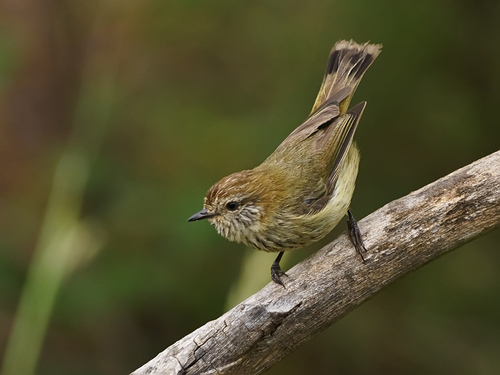The Kangaroo Island Striated Thornbill is a medium-sized thornbill about 10 cm long with a wingspan of around 14 cm and weight of 7 g. Its characteristic feature is a boldly streaked throat and chest, with black streaks on a white background. The ear coverts are similarly streaked with black and white. The belly and vent are yellow. From the frons, via the cap to the nape of the neck, the rest of the head is brown. The upperparts are olive-green with a brownish tail and grey subterminal band. The irises are light, while the bill, legs and feet are black. The sexes are similar and young birds are only slightly different to adults, with less streaking on the underside. Eggs are elongated-oval in shape and are glossy pinkish-white to pale creamy-buff with pinkish red to reddish-brown spotting and streaking.
Kangaroo Island Striated Thornbill |
Acanthiza lineata whitei
Status: Vulnerable on the EPBC Act list

Government evidence of impact of climate change:
-
Conservation Advice
The cumulative effect of the climate anomalies has led to; and will continue to; increase the likelihood of extreme events such as droughts and heatwaves (BOM CSIRO 2020).
This change in climate may have detrimental impact on Kangaroo Island Striated Thornbills and their habitat.
Climate anomalies will also increase the risk of wildfire (see Increase in frequent; large extent; high intensity wildfires).
Extreme fire weather (Di Virgilio et al. 2019 Dowdy et al. 2019) driven by longer and more severe droughts (Evans et al. 2017) and more frequent heatwaves (Herold et al. 2018) is likely to increase in frequency and intensity in coming decades and poses the greatest risk to the subspecies (Paton et al. 2021).
Analysis by the Wildlife and Threatened Species Bushfire Recovery Expert Panel; based on intersecting the modelled distribution of the Kangaroo Island Striated Thornbill and the National Indicative Aggregated Fire Extent Dataset; indicated that approximately 63 of the range of the subspecies was within the extent of the 2019 2020 bushfires (Legge et al. 2020).
An analysis done by the National Environment Science Program (NESP) Threatened Species Recovery Hub showed that a large proportion of the range of the Kangaroo Island Striated Thornbill was affected by the 2019 2020 bushfires 51 was burnt in high to very high severity fire; and a further 11 was burnt in low to moderate fire (Legge et al. 2021).
Threats The most prominent threat that has caused the subspecies to decline is frequent; large extent; high severity wildfire particularly the 2019 2020 bushfires; where half of the Kangaroo Island was impacted (Paton et al. 2021).
While fire is integral to the ecology of Kangaroo Island; the 2019 2020 bushfires were the most extreme in recorded history and were unprecedented in their scale; speed and intensity (Government of South Australia 2020b).
Extreme fire weather (Di Virgilio et al. 2019 Dowdy et al. 2019) driven by longer and more severe droughts (Evans et al. 2017) and more frequent heatwaves (Herold et al. 2018) is likely to increase in frequency and intensity in coming decades and poses the greatest risk to the subspecies (Paton et al. 2021).
The flammable nature of some weeds; including non endemic species such as Tasmanian Blue Gum (Eucalyptus globulus); may also increase fire risk and severity (Government of South Australia 2021).
Table 1 Threats impacting Kangaroo Island Striated Thornbill Threat Status and severity a Evidence Fire Increase in frequent; large Status historical; current While fire is vital to the ecology of Kangaroo extent; high intensity future Island; the 2019 2020 bushfires were the wildfires Confidence known most extreme in recorded history; burning approximately half of the island (DEW 2020 Consequence severe Todd Maurer 2020).
The fire was also Trend increasing unprecedented in its scale; speed and intensity Extent across the entire (Government of South Australia 2020a).
Proposed Extent across the entire changes include increased fire prevention range works such as prescribed burns; mechanical vegetation removal and increased asset protection zones and buffer zones (BirdLife Australia 2021; pers comm 02 July).
Ensure fire suppression strategies also consider impacts on the population or its habitat.
Information and research priorities Improve knowledge of the impacts of wildfire on the subspecies; including on its ecology; behaviour and the ability of birds to re colonise recently burnt areas.
The number of locations was determined using the 2019 2020 fire extent on Kangaroo Island; which heavily impacted the western side of Kangaroo Island; though unburnt habitat fragments remained within the fire affected area.
The risk of a fire extirpating all individuals on the eastern side of the island was considered.
Given there are lower fuel loads and less contiguous vegetation cover in east; as well as greater access to fire fighting resources; the risk of fire impacting this entire area is reduced.


